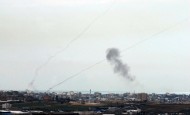NGOs Distort International Law with “Disproportional” Casualty Claims
During and after armed conflict in Gaza, a common refrain is that the higher number of Palestinian civilian casualties, relatively to Israelis, reflects a “disproportionate” response to thousands of missile attacks on Israeli population centers. This erroneous claim is repeated regularly on news and entertainment platforms, as well as by government officials, such as the EU foreign policy heads.
Like many misnomers about international law and Israel, distortions regarding proportional responses to aggression are central to NGO political advocacy campaigns that exploit legal rhetoric for demonization. As opposed to Palestinian rockets fired in large numbers toward population centers, which are unequivocal and undeniable war crimes, Israeli strikes against terror infrastructure in Gaza are legally justifiable. Even if questions can be raised about certain incidents, the issues are complex and intensely debated by international legal experts.
Moreover, without access to detailed information from the Israeli army about intelligence assessments and targeting, NGOs cannot possibly conclude definitively that Israeli actions in Gaza are illegal and “disproportionate.”
Nevertheless, as seen below, NGOs misrepresent the laws of armed conflict in a number of fundamental ways in order to accuse Israel of committing “war crimes.” NGOs:
- Count civilian deaths in a vacuum
- Erase terrorist casualties
- Ignore Hamas’ shielding of military targets in civilian areas
- Refuse to blame Hamas for Palestinian rockets that land inside Gaza
What does international law actually say?
Most media references to Israeli responses that highlight the imbalance between Israeli and Palestinian civilian casualties use the term “disproportionate” colloquially, not legally. While the discrepancy in casualties may reflect each side’s priorities (Iron Dome and bomb shelters vs. rockets and terror infrastructure), it does not define “proportionality” under the laws of armed conflict.
International law prohibits attacking civilians and non-military structures, per se, under the rules of distinction. This means that militaries must distinguish between civilians and legitimate targets.
However, international law does not prohibit killing of civilians if they are not the target, even as such deaths are tragic and upsetting. Also known as “collateral damage,” civilian casualties do not mean that a particular strike was illegal.
Rather, under international law, the harm to civilians should be proportionate to the expected military advantage from the attack. For example, if Hamas locates rocket launchers in the middle of a residential area, Israel could choose to destroy the rockets even if it knows that civilians would be killed. But, Israel is obligated to ensure that the harm to these civilians does not outweigh the military benefits of taking out these particular munitions.
Crucially, proportionality is calculated based on the expected outcome as perceived by the attacker at the time of the attack; essential information in this regard is possessed solely by the Israeli army and is not known by NGOs and the media. Proportionality cannot be determined by second guessing after the fact because of the number of allegedly civilian casualties.
Furthermore, proportionality is restricted to each individual strike. A high number of overall casualties in the conflict, while tragic, does not per se affect the legality of the operation.
NGO distortions
Counting civilian deaths in a vacuum
As detailed above, the number of overall civilian casualties does not determine the legality and moral legitimacy of an operation. Nevertheless, NGOs accuse Israel of war crimes on the basis of civilian casualties per se:
- Al-Haq Field Report, May 18: “The aggravated attacks resulted in the unnecessary and disproportionately high civilian casualties, with the Gaza Ministry of Health reporting more than 139 Palestinians have been killed and 1,038 injured as of 15 May 2021 at 12:00 pm.”
- B’Tselem Tweet by Executive Director Hagai Elad, May 17: “It’s not proportional. It’s not temporary. It’s not legal. It’s not equal. And it’s not complicated: Believe your eyes. Follow your conscience. The reason that it looks like apartheid is simply because it is apartheid.”
- Diakonia, Kvina till Kvina, and other Swedish NGOs Statement (translated by NGO Monitor), May 14: “The fact that so many people have been killed, most of them civilians and several also children, cannot be defended under international law.”
Erasing terrorist casualties
When reporting casualties of strikes, as documented, NGOs generally do not have independently verifiable information, and often conflate combatants and civilians. High casualty figures – either misidentifying terrorists as civilians or neglecting to mention the terrorist affiliations – create the appearance of wrongdoing. In the recent Gaza conflict, dozens of Hamas and Islamic Jihad casualties have already been identified.
For example, PCHR, Al-Haq, and Al Mezan reported that an Israeli airstrike on May 10 killed Saber Ibrahim Mahmoud Suleiman and his 15-year-old son in northern Gaza. None of these organizations acknowledged that Suleiman was a Hamas commander. Social media posts show the son dressed in military fatigues and carrying a weapon – indicating that he too was a combatant (and was a victim of the crime of child recruitment).
Similarly, PCHR, Al-Mezan and Al-Haq failed to note that Mohammed ‘Abdullah Zidan Fayyad, killed in an Israeli air strike on May 10, was a Hamas commander.
Ignoring Hamas’ shielding of military targets in civilian areas
A central aspect of Hamas’ and Islamic Jihad’s strategy is to shield their military operations and terror infrastructure within civilian areas. This includes: firing rockets from within population centers, constructing a vast network of tunnels under these same areas, and hiding munitions in homes and (what would otherwise be) civilian buildings. At the time, Hamas instructed Palestinians not to talk about the targets of Israeli strikes – which would reveal their military nature – reportedly “in an attempt to hide the damage caused to its tunnels and weapons arsenals.”
NGOs fail to condemn such actions as being directly responsible for increased danger and harm for the Palestinian civilians who live in the vicinity. They also publish countless statements, analyses, and reports that pretend that Gaza-based terrorists do nothing of the sort.
- Al-Mezan Press Release, May 18: “Al Mezan strongly condemns Israel’s continued disproportionate use of force and deliberate targeting of civilians and civilian infrastructure as an integral part of its military offensive in Gaza.”
- Al Shabaka Quote to CBS News from Senior Policy Analyst Yara Ahawari, May 17: “When Israel says it is bombing Hamas infrastructure, it is actually bombing civilian infrastructure … The use of Hamas as a pretext to collectively punish all Palestinians is something that Israel does time and time again.”
- Human Rights Watch Tweet from Executive Director Ken Roth, May 14: “The Israeli military has clearly decided to target apartment buildings. Whatever the office or person inside, how does the military even pretend to justify these attacks as proportionate in relation to the many people left homeless? Or is that the point?”
- Norwegian Refugee Council Press Release, May 18: “We call on Israel to stop this madness: children must be protected. Their homes must not be targets. Schools must not be targets. Spare these children and their families. Stop bombing them now.”
- Palestinian Center for Human Rights Interview on Al-Ghad TV (Egypt), May 16: “Israel clearly wants to target civilians. Civilians and civilian targets are most of those damaged. Israel has targeted, and this we have verified, towers – residential towers, broadcasters towers, banks, police centers and the streets. It is not understandable and unimaginable why these are the targets of the strongest and most technological military in the Middle East area.”
- Palestinian Center for Human Rights (PCHR) Daily Report, May 18: “PCHR strongly condemns IOF’s use of mass explosive power, which proves Israel’s intention to inflict harm on Palestinian civilians in disregard for IHL principles of distinction and proportionality.”
In addition to general statements, NGOs also ignore Hamas’ presence in specific incidents. For instance, on May 12, Israel bombed the Shuruq tower. According to the IDF, this building “housed Hamas military intelligence offices and communications equipment for transmitting tactical military information to and from the terrorist organizations in the Gaza Strip.” Al-Haq, Al-Mezan and PCHR all ignored the alleged Hamas installation when reporting on the strike.
Similarly, PCHR, DCI-P, Al-Mezan and Al-Haq reported on Palestinian civilian casualties, as well as damage to a Doctors Without Borders (MSF) facility, in a May 16 Israeli strike. Al-Haq complained about the “targeted destruction of the main artery leading to the main hospital in Gaza.” These NGOs failed to note that the May 16 Israeli strikes targeted Hamas’ extensive underground tunnel system – designed to transport and shield fighters and weaponry, and built beneath civilian infrastructure including medical facilities and roads – and not, according to the IDF, the structures and roads above the tunnels.
Refusing to blame Hamas for damage caused by Palestinian rockets that land inside Gaza
Significant civilian damage and casualties in Gaza are the direct result of terrorist attacks that fall short and do not reach the intended targets (i.e. civilians in Israel). Errant rockets have killed Palestinians and caused property damage in Gaza, including to infrastructure. According to the IDF, approximately 15% (680/4,300) of the rockets and mortars launched by Palestinian groups landed within Gaza.
In general, NGOs downplay Palestinian culpability for these incidents, reporting in obscure or passive language when they cannot blame Israel.
- According to PCHR, on May 10 “a missile fell in the middle of Saleh Dardonah Street, which was overcrowded…” killing 7, including a child. While this wording is designed to imply Israeli responsibility for the strike, another Palestinian report acknowledged that “initial investigations suggest a homemade rocket fired by a Palestinian armed group fell short and killed eight Palestinians, including two children…Palestinian security sources and explosives experts indicated the cause of this explosion was a Palestinian armed group rocket that fell short.”
- In a similar incident on the same day, Palestinian NGOs vaguely reported on a missile that “fell” or a “blast” that killed eight civilians, including six children. Al-Haq even said that the “missile targeted a gathering of civilians.” In fact, according to the IDF, “The children were killed by an errant Palestinian rocket…not Israeli fire.”
According to Israeli security officials, “Hamas rockets also damaged power lines, cutting more than 230,000 Gazans off from electricity,” and “Hamas rockets damaged power lines on the Israeli side [leading to Gaza].” In addition, the damage to gas and electricity lines by Palestinian rocket fire also impacts the operation of Gaza’s desalination plants and the ability to provide fresh water.
However, NGOs refused to attribute blame to Palestinians: According to Al-Haq, “Due to attacks on electricity infrastructure…[and] the shelling of civilian infrastructure, electricity lines in Gaza have been destroyed.” Al-Mezan claimed that “due to attacks perpetrated by Israeli forces…electricity networks…have been damaged,” baselessly charging that “[Israel] deliberately destroys electricity and water and sanitation networks.” PCHR and DCI-P made similar statements.
Relatedly, Hamas attacks have curtailed Israel’s ability to provide humanitarian aid to Gaza during the fighting. Israel opened the Erez and Kerem Shalom border crossings on May 18-19 to provide vaccines, food, and other humanitarians supplies to Palestinian civilians. Both times, Palestinians launched mortars at the area – in one instance wounding an Israeli soldier – necessitating the closing of the crossings.
These Hamas attacks went unreported by these NGOs.
Instead Al-Haq blamed “Israel’s refusal to permit imports of fuel into the Gaza Strip to supply the power plant,” on shortages, while Al-Mezan claimed that Israel “continue[s] to close Erez and Kerem Shalom Crossings, preventing patient access to healthcare and the passage of essential medical supplies and fuel.”


